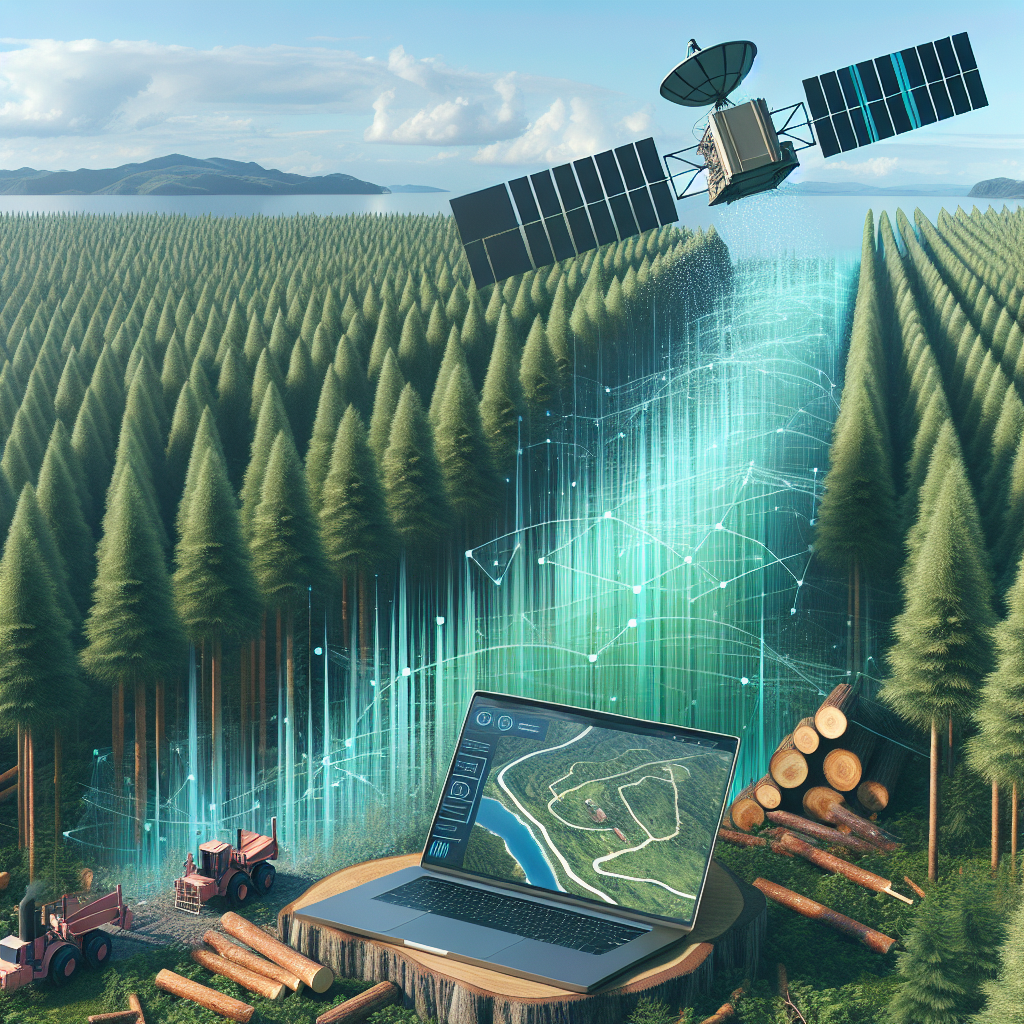
In today’s technologically advanced world, satellite internet has become an essential tool for forestry operations. This cutting-edge technology provides remote forest locations with high-speed internet access, enabling seamless communication, data collection, and monitoring of forest activities. Satellites are now being utilized to enhance efficiency, accuracy, and safety in forestry operations, from real-time tracking of logging equipment to monitoring forest fires. With satellite internet, foresters can now analyze data, communicate with team members, and make informed decisions no matter how remote the location. Say goodbye to connectivity challenges and embrace the power of satellite internet for a more productive and sustainable forestry industry.
Understanding the Importance of Reliable Connectivity in Forestry

Challenges Faced by Forestry Operations in Remote Locations
Forestry operations in remote locations encounter a multitude of challenges due to the lack of reliable connectivity. These challenges significantly impact operational efficiency and safety, highlighting the crucial need for advanced satellite internet solutions in such environments.
- Limited Access to Traditional Internet Infrastructure
Forestry operations often take place in remote, isolated areas where traditional internet infrastructure is either absent or extremely limited. The absence of fiber optic cables and other conventional connectivity options makes it difficult for forestry teams to access vital online resources, communicate effectively, and utilize digital tools for data collection and analysis.
- Need for Real-Time Data Transmission in Forestry Operations
In the forestry sector, real-time data transmission is essential for various activities such as monitoring forest health, tracking inventory, and managing equipment. However, in remote locations with poor connectivity, the ability to transmit data instantly becomes compromised. Delays in data transfer can lead to inaccuracies in decision-making processes and hinder timely responses to evolving situations in the field.
- Impact of Poor Connectivity on Efficiency and Safety
The impact of poor connectivity on forestry operations is profound, affecting both efficiency and safety. Without reliable internet access, forestry teams may struggle to coordinate activities, access up-to-date information on weather patterns or fire risks, and communicate effectively in case of emergencies. This lack of connectivity not only slows down operational processes but also poses significant safety risks to workers in the field, especially during critical situations that require immediate assistance or coordination.
The Role of Satellite Internet in Overcoming Connectivity Limitations
Satellite internet plays a crucial role in overcoming connectivity limitations in forestry operations, particularly in remote and isolated areas where traditional internet infrastructure is lacking. This technology offers a reliable and robust solution to ensure seamless communication and data transfer for forestry management activities. Here are some key points highlighting the significance of satellite internet in this context:
- Advantages of Satellite Internet for Remote Locations
- Satellite internet provides connectivity to even the most remote forestry sites, where terrestrial options like cable or DSL are unavailable.
-
By leveraging satellites orbiting the Earth, forestry operations can access high-speed internet regardless of their geographical location, enabling real-time data transmission and communication.
-
How Satellite Internet Works in Forestry Operations
- Satellite internet operates by transmitting data between a satellite dish at the forestry site and a satellite in geostationary orbit above the Earth.
-
The satellite acts as a relay station, receiving data from the forestry operation’s dish and transmitting it back to Earth, ensuring constant connectivity even in areas with challenging terrain or limited infrastructure.
-
Benefits of Reliable Connectivity for Forestry Management
- Reliable satellite internet connectivity allows forestry teams to access online resources, collaborate effectively, and communicate with stakeholders regardless of their location.
- Real-time data transmission facilitated by satellite internet enables efficient monitoring of forestry activities, including inventory management, mapping, and environmental assessments.
In conclusion, satellite internet serves as a vital tool in forestry operations, overcoming connectivity limitations and enabling seamless communication and data exchange in remote and challenging environments. Its role in enhancing efficiency and productivity in forestry management cannot be understated, making it a valuable asset for modern forestry practices.
Implementing Satellite Internet Solutions in Forestry Operations
Choosing the Right Satellite Internet Provider
When considering satellite internet providers for forestry operations, it is crucial to assess various factors to ensure optimal connectivity and reliability in remote locations. Here are key considerations to keep in mind:
-
Coverage Area: Evaluate the provider’s coverage map to confirm that the intended forestry sites fall within the satellite’s footprint. Reliable coverage is essential for seamless operations in remote areas where traditional internet infrastructure may be lacking.
-
Bandwidth Options: Different forestry operations may have varying bandwidth requirements based on the size of the team, the nature of tasks, and data transfer needs. Select a provider that offers flexible bandwidth options to accommodate the specific demands of the forestry activities.
-
Latency and Speed: In forestry operations where real-time data transmission is critical for decision-making processes, low latency and high-speed connections are paramount. Assess the provider’s latency rates and download/upload speeds to ensure they meet the operational needs.
-
Reliability and Redundancy: Forestry operations often require continuous connectivity to monitor activities, track resources, and communicate effectively. Choose a provider with a reputation for reliability and redundancy measures in place to minimize downtime and disruptions.
-
Customer Support: In remote forestry locations, prompt and efficient customer support is essential for troubleshooting connectivity issues and ensuring minimal downtime. Prioritize providers with responsive customer service teams available to assist 24/7.
-
Scalability: As forestry operations expand or project requirements change, the internet needs may also evolve. Opt for a provider that offers scalable solutions, allowing for easy upgrades or adjustments to accommodate growth and evolving connectivity demands.
Installation and Setup Process for Satellite Internet Systems
When implementing satellite internet solutions in forestry operations, the installation and setup process play a crucial role in ensuring seamless connectivity for various activities in remote locations. The following steps outline the detailed procedure for setting up satellite internet systems:
Preparing the site for satellite dish placement
- Site Survey: Conduct a thorough site survey to determine the best location for optimal signal reception. Consider factors such as line of sight to the satellite, obstacles like trees or buildings, and elevation angles.
- Clearing the Area: Clear any foliage or obstructions that may obstruct the satellite signal path. Ensure there are no tall trees or structures blocking the line of sight to the satellite.
- Ground Stability: Ensure the ground where the satellite dish will be placed is stable and level to prevent any movement or misalignment once the dish is installed.
Connecting and configuring satellite internet equipment
- Mounting the Dish: Securely mount the satellite dish on a stable surface using the appropriate mounting brackets. Ensure the dish is pointing towards the satellite at the correct azimuth and elevation angles.
- Connecting Cables: Connect the coaxial cable from the satellite dish to the modem inside the building. Ensure the cable is properly secured and free from any damage that may affect signal quality.
- Power Supply: Connect the modem and other equipment to a reliable power source to ensure uninterrupted connectivity.
- Configuration: Follow the manufacturer’s instructions to configure the modem and satellite equipment. Input the necessary settings such as satellite parameters and network details to establish a connection.
Testing and optimizing the system for optimal performance
- Signal Strength: Use a signal meter to check the signal strength and quality to ensure it meets the required standards for stable connectivity.
- Speed Test: Conduct speed tests to evaluate the performance of the satellite internet connection. Verify upload and download speeds to confirm the system is operating at the expected levels.
- Troubleshooting: Address any connectivity issues or performance discrepancies by troubleshooting the system. Check for any signal interference or equipment malfunctions that may impact performance.
- Optimization: Fine-tune the system settings and configurations to optimize performance based on the specific requirements of forestry operations. Adjust antenna alignment or network settings as needed to enhance connectivity.
By following these steps for installation and setup of satellite internet systems in forestry operations, organizations can establish reliable connectivity in remote areas to support various activities and communication needs.

Maximizing Efficiency and Safety with Satellite Internet
Real-Time Data Monitoring and Analysis
Satellite internet technology has revolutionized the way forestry operations monitor and analyze data in real-time, providing valuable insights and enhancing overall efficiency and safety. Utilizing this advanced connectivity tool, forestry professionals can track forest resources and environmental conditions with unprecedented accuracy and timeliness. By receiving up-to-date information through satellite internet, decision-making processes are significantly improved as stakeholders have access to the most current data available.
Tracking forest resources and environmental conditions:
– Satellite internet enables forestry operations to continuously monitor the status of forest resources such as tree health, growth patterns, and biodiversity.
– Environmental conditions like weather patterns, soil moisture levels, and potential natural hazards can be closely tracked and analyzed in real-time.
– This real-time tracking allows forestry professionals to make proactive decisions to mitigate risks and optimize resource management strategies.
Improving decision-making processes with up-to-date information:
– With the ability to access real-time data through satellite internet, forestry operations can make informed decisions promptly, reducing response times to critical events.
– The availability of current information on forest conditions and environmental factors empowers stakeholders to implement adaptive management strategies effectively.
– By incorporating real-time data into decision-making processes, forestry operations can enhance operational efficiency and maximize the sustainable use of resources.
Enhancing operational efficiency and resource management:
– Real-time data monitoring and analysis facilitated by satellite internet technology streamline operational processes, leading to increased productivity and cost-effectiveness.
– Forestry operations can optimize resource allocation and utilization based on the most recent data insights, minimizing waste and improving overall efficiency.
– The enhanced ability to monitor and analyze data in real-time through satellite internet contributes to safer working conditions for forestry professionals, ensuring optimal resource management practices.
Communication and Collaboration in Remote Forestry Sites
In remote forestry sites, communication and collaboration are vital components for ensuring the efficiency and safety of operations. Satellite internet plays a crucial role in bridging the communication gap between field workers and headquarters, enabling seamless coordination and feedback loops in forestry activities.
-
Facilitating communication between field workers and headquarters: Satellite internet allows real-time communication through emails, instant messaging, and voice calls, enabling field workers to report findings, receive instructions, and seek assistance promptly. This direct line of communication enhances operational efficiency and ensures that critical information is relayed without delays.
-
Conducting virtual meetings and training sessions: With satellite internet, forestry organizations can conduct virtual meetings and training sessions for field workers located in remote areas. This capability is particularly beneficial for disseminating important updates, sharing best practices, and providing continuous education to enhance the skills and knowledge of forestry personnel.
-
Ensuring seamless coordination and feedback loops in operations: By utilizing satellite internet, forestry teams can maintain constant coordination among team members spread across different locations. This enables swift decision-making, effective resource allocation, and timely responses to changing conditions in the field. Additionally, the feedback loop facilitated by satellite internet allows for the continuous improvement of operational processes based on real-time data and insights gathered from the field.

In conclusion, communication and collaboration in remote forestry sites are significantly enhanced through the utilization of satellite internet, enabling forestry operations to run smoothly, efficiently, and with a heightened focus on safety.
Addressing Security and Reliability Concerns in Satellite Internet Usage
Ensuring Data Security and Privacy
In forestry operations, ensuring data security and privacy is paramount when utilizing satellite internet services. To safeguard sensitive information and maintain privacy standards, several key measures can be implemented:
-
Implementing encryption and secure data transmission protocols: Utilizing advanced encryption algorithms such as SSL/TLS can help protect data in transit between forestry personnel and central databases. By encrypting data packets, unauthorized access or interception can be mitigated, ensuring the confidentiality and integrity of information.
-
Protecting sensitive information from cyber threats: Deploying robust firewalls, intrusion detection systems, and antivirus software can fortify the network against potential cyber threats. Regular security audits and vulnerability assessments can help identify and address any weaknesses in the system that could compromise data security.
-
Compliance with data protection regulations in forestry operations: Adhering to industry-specific data protection regulations, such as the General Data Protection Regulation (GDPR) or the Forestry Stewardship Council (FSC) guidelines, is essential. Ensuring that data collection, storage, and processing practices align with these regulations can help prevent data breaches and maintain the trust of stakeholders.
By implementing a comprehensive approach to data security and privacy, forestry operations can leverage satellite internet services effectively while safeguarding sensitive information from unauthorized access or data breaches.
Backup and Redundancy Planning for Uninterrupted Connectivity
Satellite internet connectivity is crucial for forestry operations, where remote locations and challenging terrain can make traditional internet options unreliable. To address the security and reliability concerns associated with satellite internet usage in forestry operations, it is essential to have a robust backup and redundancy planning in place. This ensures uninterrupted connectivity even in the face of unforeseen circumstances.
- Developing contingency plans for satellite internet outages:
-
Forestry companies should create detailed contingency plans outlining steps to take in the event of satellite internet outages. These plans may include alternative communication methods, such as mobile hotspots or satellite phones, to maintain essential connectivity during downtime.
-
Utilizing backup communication systems in case of emergencies:
-
In addition to satellite internet, forestry operations should have backup communication systems in place for emergencies. This could involve establishing radio communication networks, which are not reliant on satellite connectivity and can provide a reliable means of communication in critical situations.
-
Maintaining service reliability through redundancy measures:
- Implementing redundancy measures is essential to ensure continuous satellite internet connectivity. This may involve using multiple satellite internet providers to minimize the risk of service disruptions. By diversifying providers, forestry operations can maintain connectivity even if one provider experiences technical issues or outages.
Future Trends and Innovations in Satellite Internet for Forestry
Advancements in Satellite Technology for Enhanced Connectivity
Satellite technology continues to evolve, providing forestry operations with enhanced connectivity and innovative solutions. These advancements are revolutionizing the way forestry professionals manage and monitor their resources. Some key developments include:
- High Throughput Satellites (HTS): HTS technology offers higher data transmission speeds and increased bandwidth capacity, allowing forestry operations to access real-time data and imagery more efficiently.
- Low Earth Orbit (LEO) Satellites: LEO satellites are being leveraged to reduce latency and improve connectivity for remote forestry locations, enabling seamless communication and data transfer.
- Adaptive Antenna Systems: Advanced antenna systems are enhancing signal reception and transmission, optimizing satellite internet performance in challenging environments such as dense forests.
- Satellite Constellations: Constellations of small satellites are expanding coverage areas and reducing downtime for forestry operations, ensuring continuous connectivity for critical applications.
- Secure Data Transmission: Encryption protocols and secure communication channels are being integrated into satellite internet systems, safeguarding sensitive forestry data from cyber threats and unauthorized access.
These advancements in satellite technology are empowering forestry professionals to make data-driven decisions, improve operational efficiency, and enhance overall productivity in forestry management practices.
FAQs: Satellite Internet for Forestry Operations
What is satellite internet and how can it benefit forestry operations?
Satellite internet is a type of internet service that relies on communication satellites in orbit around the Earth to provide connectivity. In forestry operations, satellite internet can be a crucial tool for accessing real-time data, conducting research, communicating with team members, and monitoring remote sites. It can enable seamless communication and data transfer in areas where traditional internet infrastructure is lacking.
How reliable is satellite internet for forestry operations?
Satellite internet is known for its reliability, as it is not dependent on physical infrastructure like cables or towers. This means that it can provide consistent and stable connectivity even in remote or rural areas where traditional internet services may be unreliable or unavailable. However, weather conditions such as heavy rain or snow can potentially disrupt satellite signals, so it is important to consider this factor when using satellite internet for forestry operations.
What are the advantages of using satellite internet over other types of internet for forestry operations?
One major advantage of satellite internet for forestry operations is its ability to provide connectivity in remote locations where other types of internet services may not be accessible. Satellite internet also offers high bandwidth capabilities, which can support data-intensive tasks such as downloading large files, streaming video, or conducting live video conferences. Additionally, satellite internet can be quickly deployed and set up, making it a convenient option for temporary or mobile forestry operations.
How do I choose the right satellite internet plan for my forestry operations?
When selecting a satellite internet plan for forestry operations, it is important to consider factors such as bandwidth requirements, coverage area, reliability, and cost. Some satellite internet providers offer specialized plans for businesses and organizations that require high data speeds and reliable connectivity. It is also recommended to research different providers and compare their features, pricing, and customer reviews to determine the best option for your specific forestry operations needs.
RELATED POSTS
View all

